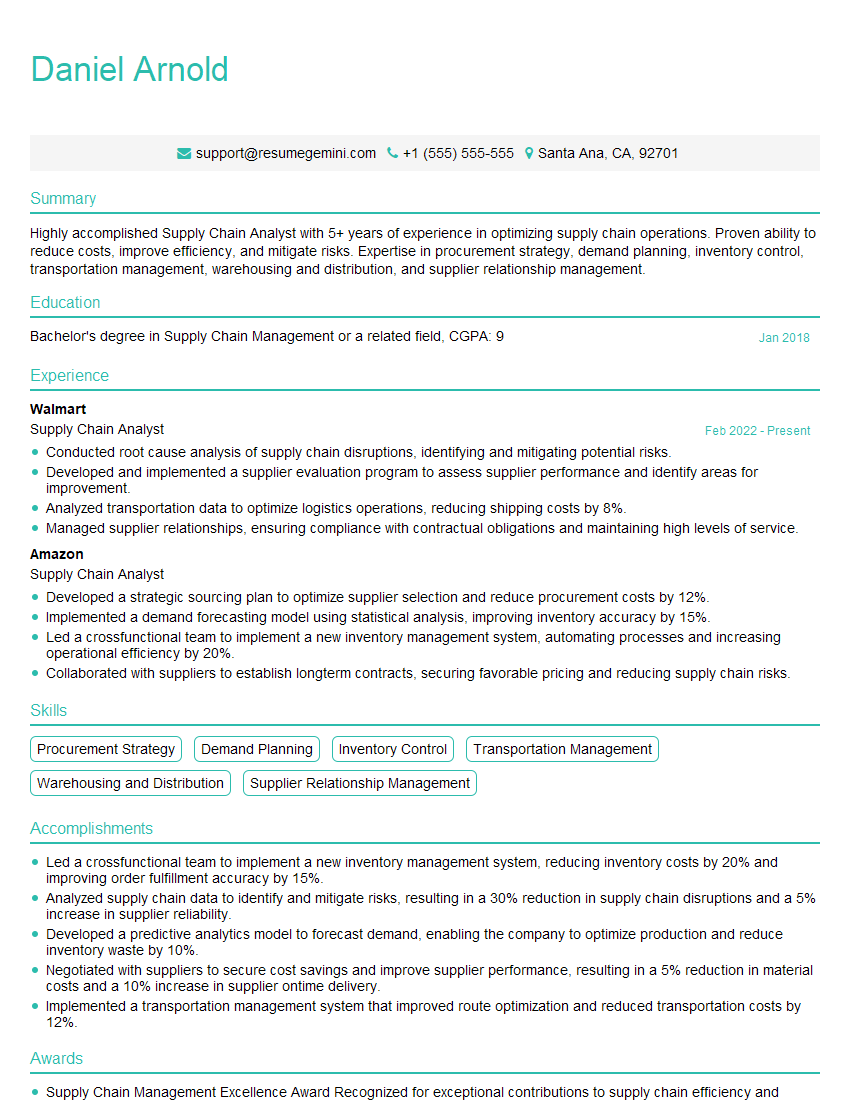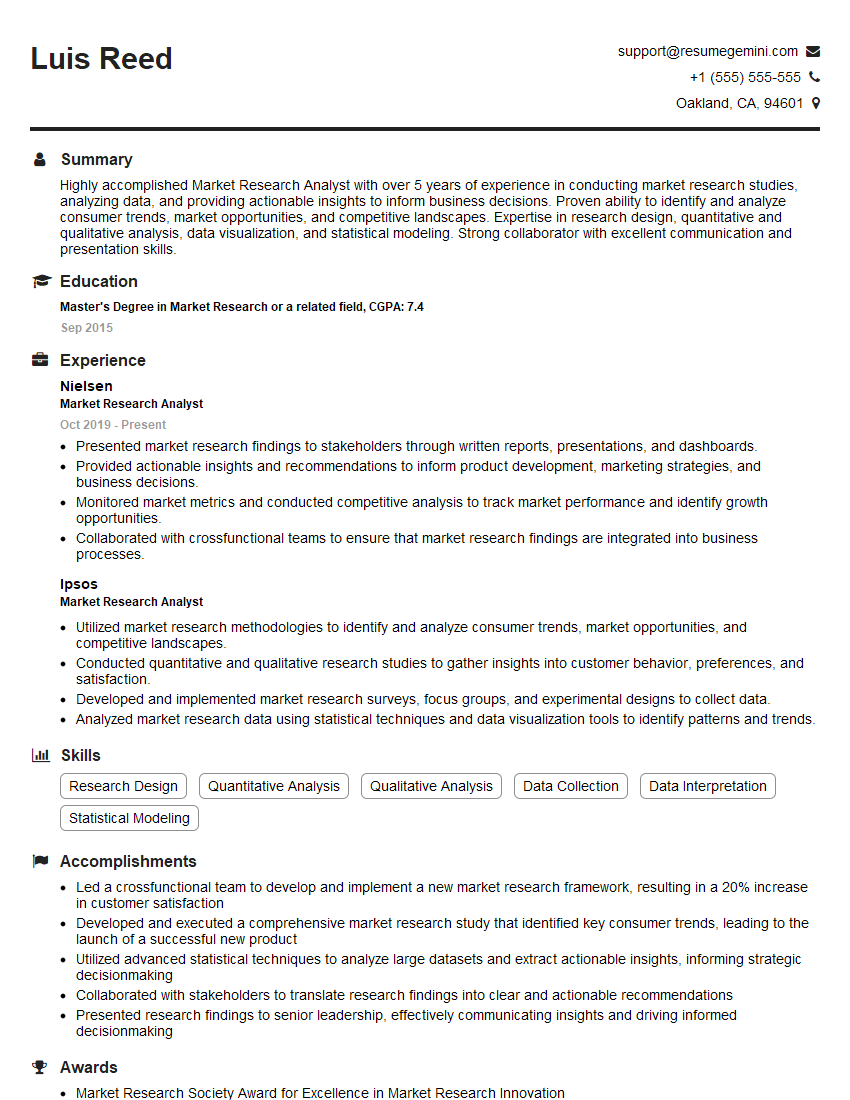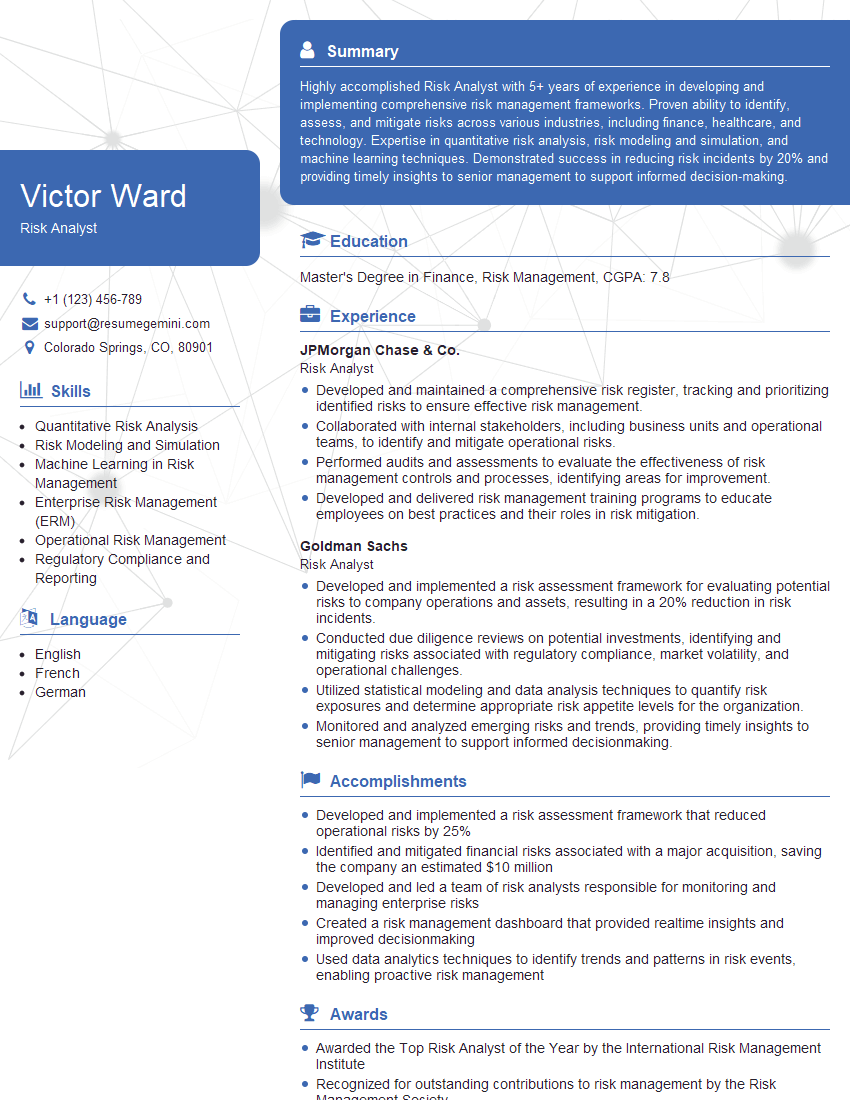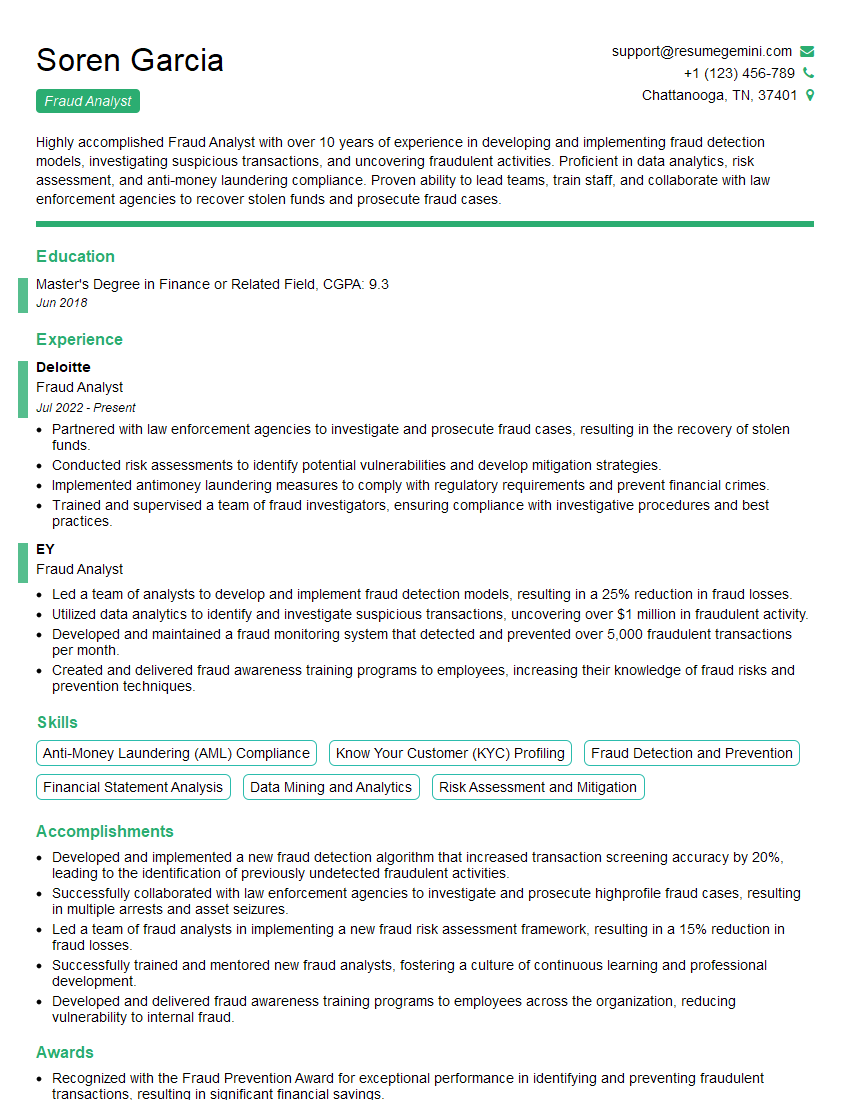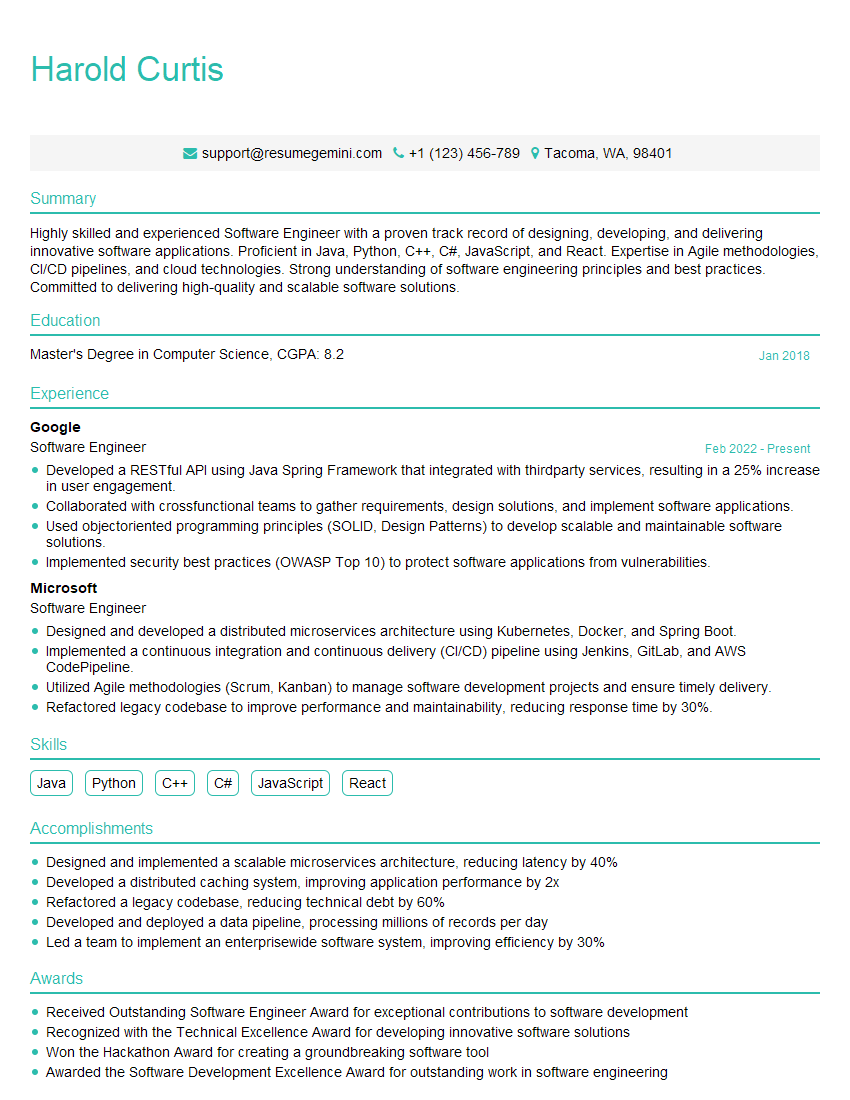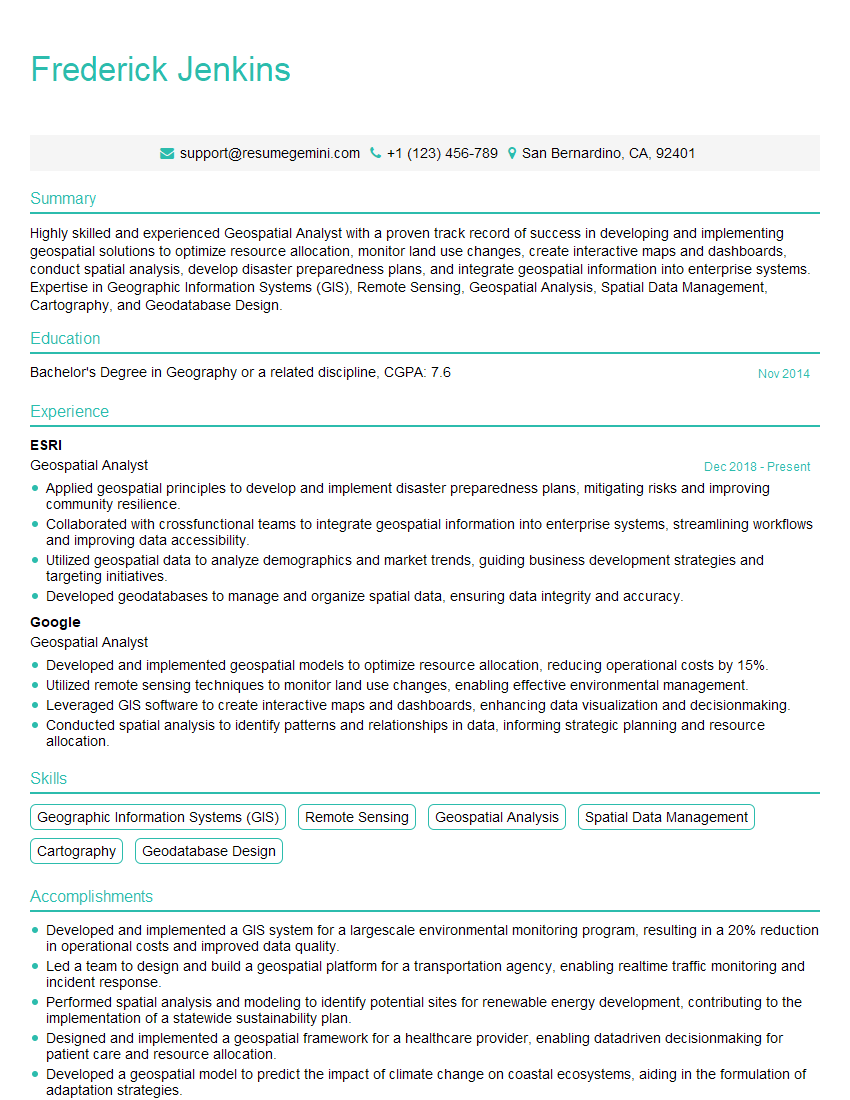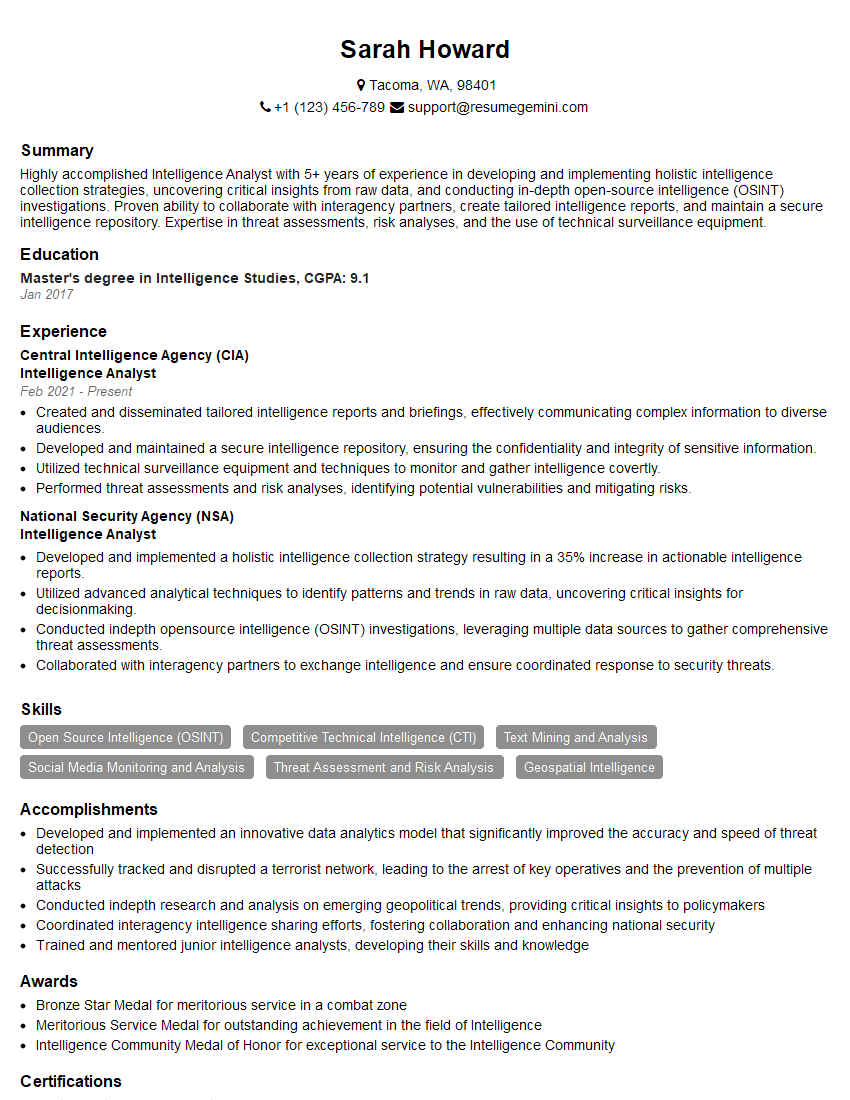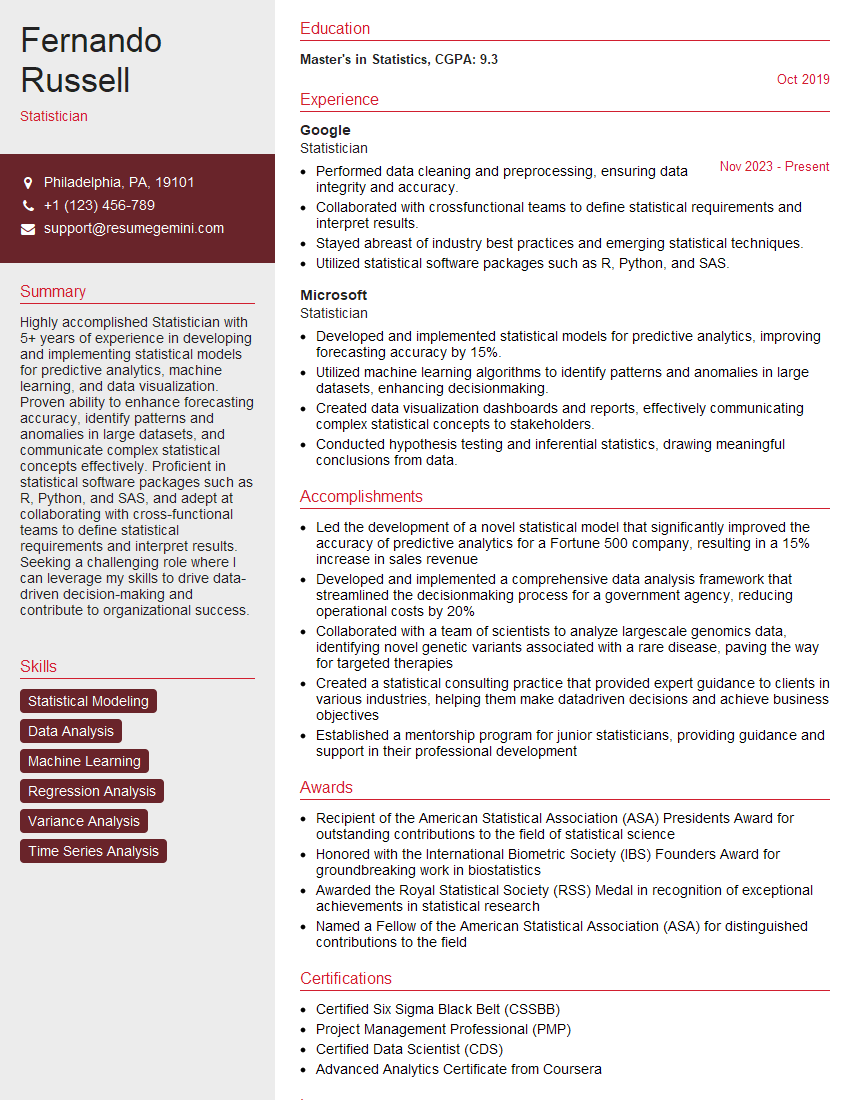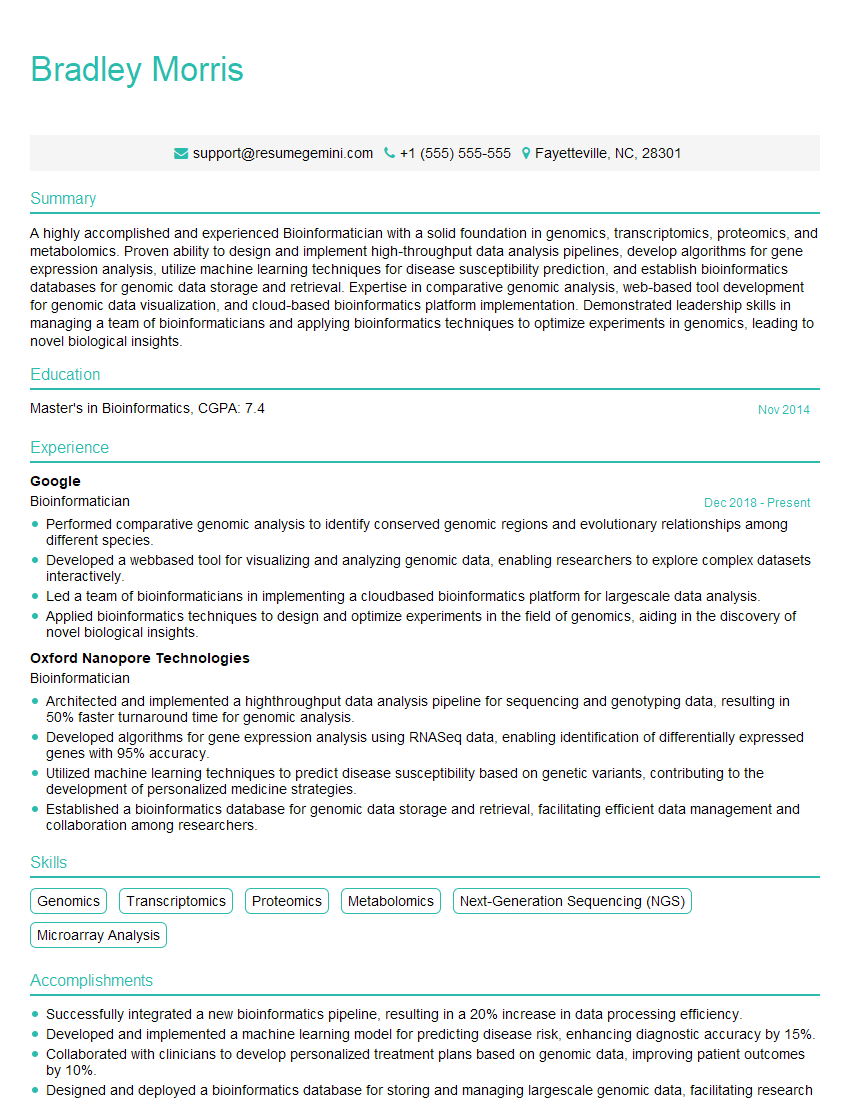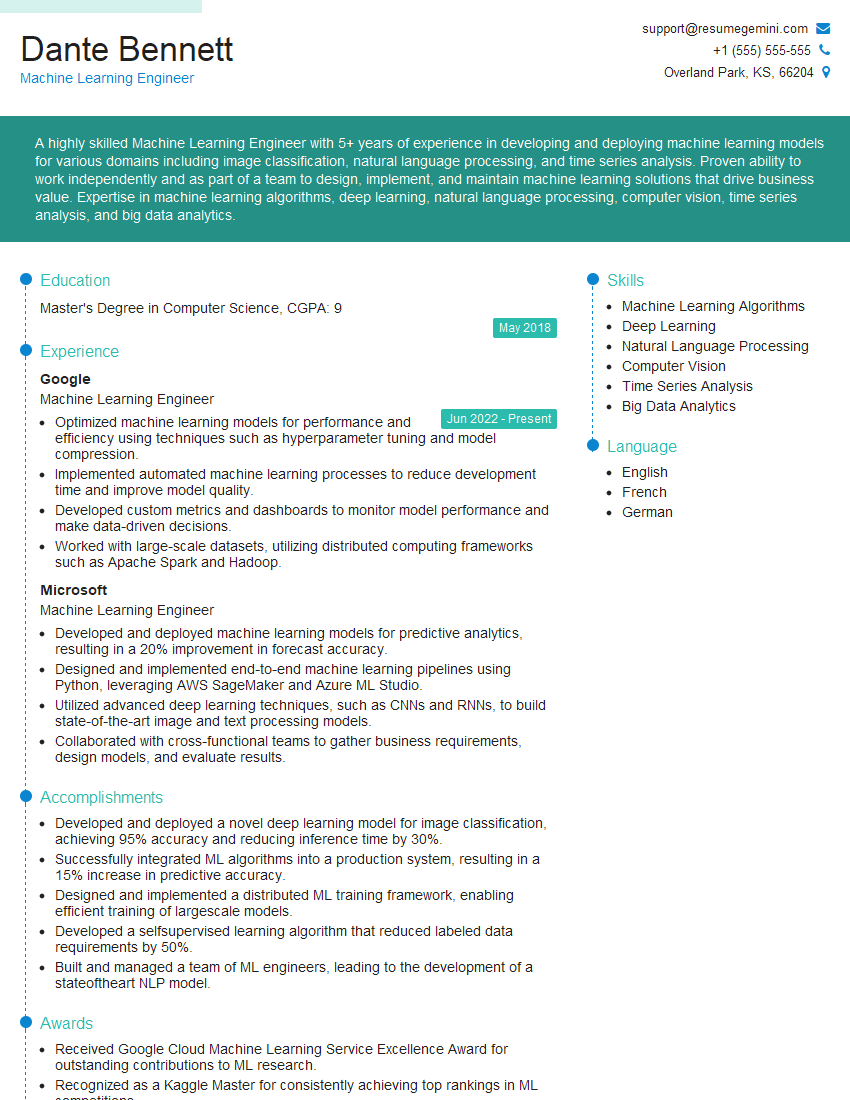Interviews are opportunities to demonstrate your expertise, and this guide is here to help you shine. Explore the essential Pattern Reading and Understanding interview questions that employers frequently ask, paired with strategies for crafting responses that set you apart from the competition.
Questions Asked in Pattern Reading and Understanding Interview
Q 1. Describe your approach to identifying patterns in complex datasets.
Identifying patterns in complex datasets is a multi-step process that blends intuition, statistical methods, and domain expertise. My approach starts with a thorough understanding of the data’s context – what it represents, how it was collected, and what questions we’re trying to answer. I then proceed with a systematic investigation, combining exploratory data analysis (EDA) with various pattern recognition techniques.
EDA involves visualizing the data using histograms, scatter plots, box plots, and other techniques to identify potential trends and outliers. This visual exploration helps to formulate hypotheses about patterns. Following EDA, I employ statistical methods like correlation analysis, principal component analysis (PCA), and clustering algorithms (like k-means or hierarchical clustering) to uncover more subtle relationships. If the data has a temporal component, time series analysis techniques, such as moving averages or ARIMA models, will be employed. Finally, I validate identified patterns using techniques like cross-validation to ensure they are robust and not merely artifacts of the data.
For example, in analyzing customer purchase data, EDA might reveal a seasonal surge in sales during the holiday season. Further analysis using correlation techniques could highlight which product categories are most strongly correlated with this seasonal increase.
Q 2. How do you differentiate between noise and meaningful patterns in data?
Distinguishing between noise and meaningful patterns is crucial in pattern recognition. Noise represents random fluctuations or errors in the data, while meaningful patterns reveal underlying structure or relationships. This differentiation often requires a combination of statistical methods and domain knowledge.
One crucial technique is to consider the scale of the pattern. Small, isolated deviations from the average might be noise, while consistent deviations across a large portion of the data likely indicate a meaningful pattern. Statistical significance tests, such as hypothesis testing, help quantify the likelihood that an observed pattern is due to chance. A p-value below a pre-defined threshold (e.g., 0.05) suggests the pattern is statistically significant and unlikely to be noise.
Data smoothing techniques can also help separate noise from patterns. Moving averages, for instance, can filter out short-term fluctuations, revealing underlying trends. Additionally, domain knowledge plays a vital role; understanding the data’s origins and potential sources of error can help identify potential noise sources and distinguish them from meaningful variations.
For instance, in a time series of stock prices, daily fluctuations can be noise, while a long-term upward trend represents a meaningful pattern. Understanding the factors influencing the stock (e.g., company performance, market trends) is essential in interpreting the observed patterns.
Q 3. Explain a time you successfully identified a previously unknown pattern.
During a project analyzing sensor data from a manufacturing plant, I discovered an unexpected pattern in the machine’s operational efficiency. The initial analysis focused on identifying major equipment malfunctions, using standard deviation and anomaly detection algorithms. However, a detailed time series analysis revealed subtle, recurring dips in efficiency that coincided with seemingly unrelated minor fluctuations in temperature and humidity within the facility.
This initially appeared to be noise, but further investigation, including correlating the data with maintenance logs, revealed that these subtle environmental changes were impacting the machine’s performance more than originally assumed. This pattern was previously unknown because the focus was solely on major malfunctions. This discovery led to the implementation of a more robust environmental control system, resulting in a significant increase in overall productivity and reduced downtime.
Q 4. What techniques do you use to visualize and interpret patterns?
Data visualization is an indispensable tool for pattern recognition. The choice of visualization technique depends heavily on the nature of the data and the type of patterns being investigated. I frequently use a variety of tools and techniques:
- Scatter plots to identify correlations between two variables.
- Histograms and density plots to understand the distribution of a single variable.
- Box plots to compare the distribution of a variable across different groups.
- Heatmaps to visualize correlations between multiple variables.
- Network graphs to visualize relationships between entities.
- Interactive dashboards for exploratory analysis and pattern exploration.
For example, in analyzing customer demographics, a scatter plot could show the relationship between age and income, while a heatmap might reveal correlations between different product purchases. The choice of visualization informs the pattern that we observe and our next step.
Q 5. How do you handle missing data when identifying patterns?
Missing data is a common challenge in pattern recognition. Ignoring it can lead to biased or inaccurate results. Several strategies can be employed to handle missing data:
- Deletion: Removing data points or variables with missing values (listwise or pairwise deletion). This is simplest but can lead to significant information loss if many values are missing.
- Imputation: Replacing missing values with estimated values. Techniques include mean/median imputation, k-nearest neighbors imputation, and more sophisticated methods like multiple imputation. Imputation avoids data loss but can introduce bias if not done carefully.
- Model-based approaches: Using statistical models to predict missing values. This can be more accurate than simple imputation methods, especially for complex datasets.
The best approach depends on the nature and extent of the missing data. For instance, if missing data is random and constitutes a small percentage of the dataset, simple imputation might be sufficient. However, if missing data is systematic or substantial, model-based approaches or specialized techniques for handling missing data in specific algorithms might be more appropriate.
Q 6. Describe your experience with different pattern recognition algorithms.
My experience encompasses a broad range of pattern recognition algorithms, including:
- Clustering algorithms: K-means, hierarchical clustering, DBSCAN – used for grouping similar data points.
- Classification algorithms: Logistic regression, support vector machines (SVMs), decision trees, random forests, naive Bayes – used for predicting categorical outcomes.
- Regression algorithms: Linear regression, polynomial regression, support vector regression (SVR) – used for predicting continuous outcomes.
- Association rule mining algorithms: Apriori, FP-Growth – used for discovering relationships between variables in transactional data.
- Neural networks: Used for complex pattern recognition tasks, particularly in image and speech recognition.
The choice of algorithm depends on the specific task, the type of data, and the desired outcome. For example, k-means clustering is suitable for grouping customers based on their purchasing behavior, while logistic regression can be used to predict customer churn.
Q 7. How do you evaluate the significance of identified patterns?
Evaluating the significance of identified patterns involves both statistical and practical considerations. Statistical measures help quantify the confidence in the identified patterns, while practical considerations assess their usefulness and impact.
Statistical Significance: This is assessed using p-values, confidence intervals, and other statistical tests. A low p-value indicates that the observed pattern is unlikely to have occurred by chance. However, statistical significance alone is not sufficient; a pattern might be statistically significant but lack practical relevance.
Practical Significance: This involves considering the magnitude of the effect, the cost of implementing any resulting actions, and the potential impact on the business or research goals. A pattern might be statistically significant but too small to be practically useful. For example, a statistically significant improvement in sales might be negligible compared to the cost of implementing the change. A comprehensive evaluation combines both statistical and practical considerations to ensure identified patterns are both robust and meaningful.
Q 8. How do you communicate complex patterns to non-technical audiences?
Communicating complex patterns to non-technical audiences requires translating technical jargon into plain language and using visual aids. Instead of saying “We observed a significant increase in variance within the time series data,” I’d say something like, “We saw a lot more ups and downs in the data over time.”
I often use analogies to explain abstract concepts. For instance, to explain clustering algorithms, I might compare them to sorting laundry: different types of clothing (data points) are grouped together based on shared characteristics (color, fabric). Visualizations are crucial; charts, graphs, and even simple diagrams can help illustrate patterns far more effectively than lengthy explanations. Interactive dashboards are even better, allowing the audience to explore the data themselves and discover patterns.
For example, when explaining a customer segmentation model to a marketing team, I’d focus on the distinct characteristics of each segment (e.g., demographics, buying habits) and how those insights can be used to tailor marketing campaigns. I’d avoid technical terms like ‘k-means clustering’ and instead emphasize the practical implications.
Q 9. What are the limitations of pattern recognition techniques?
Pattern recognition techniques, while powerful, have inherent limitations. One key limitation is the inherent bias in the data used to train the models. If the training data doesn’t accurately reflect the real-world distribution, the model will likely perform poorly on unseen data. This is especially true with imbalanced datasets, where one class significantly outweighs others.
Another limitation is the ‘curse of dimensionality.’ As the number of features (variables) increases, the data becomes increasingly sparse, making it harder to identify meaningful patterns and increasing computational complexity. Overfitting is also a significant concern; a model might perform exceptionally well on training data but poorly on new data because it has memorized the training data’s noise rather than learning underlying patterns.
Finally, the interpretability of some advanced techniques can be challenging. Deep learning models, for example, are often described as ‘black boxes,’ making it difficult to understand how they arrive at their conclusions. This lack of transparency can limit their applicability in situations where understanding the decision-making process is crucial (e.g., medical diagnosis).
Q 10. How do you handle inconsistent or conflicting patterns?
Handling inconsistent or conflicting patterns requires a careful and systematic approach. First, I’d investigate the source of the inconsistencies. Are there errors in the data? Are there multiple underlying patterns that are being conflated? Data cleaning and preprocessing steps are essential here – identifying and correcting errors, handling missing values, and potentially transforming variables.
Once the data is cleaned, I might employ techniques like ensemble methods (combining multiple models) to improve robustness. These methods can help reduce the impact of noisy or conflicting data points. Another strategy is to segment the data based on the observed inconsistencies, recognizing that there might be distinct patterns within different subsets of the data. Hierarchical clustering or other segmentation algorithms can be helpful here.
For example, in fraud detection, inconsistent patterns might indicate new fraud tactics. Instead of discarding these outliers, a careful analysis can uncover valuable insights leading to improved fraud detection models.
Q 11. Explain the difference between supervised and unsupervised pattern recognition.
Supervised and unsupervised pattern recognition differ fundamentally in how they’re trained and used. In supervised learning, the algorithm is trained on a labeled dataset, meaning each data point is associated with a known class or outcome. The algorithm learns to map input features to these known outputs. Examples include image classification (identifying cats vs. dogs) and spam detection.
Unsupervised learning, on the other hand, deals with unlabeled data. The algorithm is tasked with identifying patterns and structures in the data without any prior knowledge of the classes or outcomes. Clustering is a prime example of unsupervised learning, where the algorithm groups similar data points together. Anomaly detection is another, identifying data points that deviate significantly from the norm.
To illustrate the difference, imagine analyzing customer purchase data. A supervised approach might predict which customers are likely to churn based on historical data where churn is already labeled. An unsupervised approach might cluster customers into different segments based on their purchasing behavior, without knowing beforehand who will churn.
Q 12. Describe your experience with time series pattern analysis.
Time series pattern analysis is a significant part of my work. I have extensive experience analyzing various time series data, including stock prices, sensor readings, and sales data. My approaches typically involve a combination of techniques depending on the specific application and the characteristics of the data.
I often start with exploratory data analysis, visualizing the data to identify trends, seasonality, and cyclical patterns. Then, I might employ techniques like moving averages to smooth out noise, ARIMA models for forecasting, or decomposition methods to separate different components of the time series (trend, seasonality, residuals). For non-linear patterns, I often explore recurrent neural networks (RNNs), such as LSTMs, which are particularly well-suited for analyzing sequential data.
For example, I recently worked on a project analyzing sensor data from manufacturing equipment to predict potential equipment failures. By identifying recurring patterns in the sensor readings leading up to failures, we were able to develop a predictive maintenance system that significantly reduced downtime.
Q 13. How do you handle high-dimensional data when searching for patterns?
High-dimensional data presents significant challenges in pattern recognition due to the curse of dimensionality. Strategies for handling this include dimensionality reduction techniques, feature selection, and manifold learning.
Dimensionality reduction techniques, such as Principal Component Analysis (PCA) and t-distributed Stochastic Neighbor Embedding (t-SNE), aim to reduce the number of features while preserving important information. PCA transforms the data into a lower-dimensional space by identifying principal components that capture the most variance in the data. t-SNE is better suited for visualization, creating a low-dimensional representation that preserves the local neighborhood structure of the data points.
Feature selection aims to identify the most relevant features for pattern recognition. This can be done through filter methods (ranking features based on statistical measures), wrapper methods (evaluating feature subsets based on model performance), or embedded methods (incorporating feature selection within the model training process).
Manifold learning assumes that high-dimensional data often lies on a low-dimensional manifold embedded in the high-dimensional space. Algorithms like Isomap and Locally Linear Embedding (LLE) attempt to uncover this underlying low-dimensional structure.
Q 14. What are some common pitfalls in pattern recognition?
Several common pitfalls can hinder effective pattern recognition. One is the overreliance on correlation without considering causality. Just because two variables are correlated doesn’t mean one causes the other; there might be a confounding factor or spurious correlation. Another pitfall is the assumption of linearity; many real-world patterns are non-linear and require non-linear models for accurate representation.
Overfitting is another major problem; models that are too complex can memorize the training data’s noise, leading to poor generalization to new data. This is often addressed through regularization techniques, cross-validation, and careful model selection. Ignoring data biases is also crucial; biased data can lead to biased models that perpetuate existing inequalities. Finally, neglecting to evaluate the model’s performance using appropriate metrics can lead to incorrect conclusions about its effectiveness.
For instance, solely relying on accuracy as a metric in a classification problem with imbalanced classes can be misleading, since a model might achieve high accuracy by correctly classifying the majority class while failing to identify the minority class, which may be critical in certain applications.
Q 15. Explain how you’d approach identifying patterns in unstructured data (e.g., text).
Identifying patterns in unstructured text data requires a multi-faceted approach. Think of it like detective work – you need to gather clues, analyze them, and build a theory. First, I’d perform text preprocessing, cleaning the data by removing irrelevant characters, converting to lowercase, and handling missing values. Then, I’d employ several techniques:
- Frequency Analysis: Counting word occurrences to identify frequently used terms which might indicate themes or topics. For example, frequent mention of ‘climate change’ suggests a focus on environmental issues.
- N-gram Analysis: Examining sequences of N words to uncover phrases and collocations. This helps find more contextual patterns, like the frequent appearance of ‘machine learning algorithms’ indicating a discussion of AI.
- Topic Modeling (e.g., Latent Dirichlet Allocation – LDA): This statistical technique discovers underlying thematic structures in a collection of documents. Imagine LDA as a tool to group related documents based on the words they contain.
- Sentiment Analysis: Determining the emotional tone (positive, negative, neutral) expressed in the text. This could reveal customer opinions about a product or public sentiment about a political event.
- Regular Expressions: For targeted pattern identification, such as finding email addresses, phone numbers, or specific date formats.
The combination of these techniques allows a comprehensive understanding of underlying patterns within the unstructured text.
Career Expert Tips:
- Ace those interviews! Prepare effectively by reviewing the Top 50 Most Common Interview Questions on ResumeGemini.
- Navigate your job search with confidence! Explore a wide range of Career Tips on ResumeGemini. Learn about common challenges and recommendations to overcome them.
- Craft the perfect resume! Master the Art of Resume Writing with ResumeGemini’s guide. Showcase your unique qualifications and achievements effectively.
- Don’t miss out on holiday savings! Build your dream resume with ResumeGemini’s ATS optimized templates.
Q 16. Describe your experience using specific software tools for pattern recognition (e.g., Python libraries).
My experience with pattern recognition tools centers heavily around Python libraries. I’m proficient with:
- Scikit-learn: This library provides a comprehensive suite of tools for machine learning, including algorithms for classification, clustering, and dimensionality reduction, crucial for identifying and characterizing patterns. I’ve used it extensively for tasks like building topic models (using LDA), implementing sentiment analysis classifiers (e.g., Naive Bayes, Support Vector Machines), and performing clustering (e.g., K-means) to group similar data points.
- NLTK (Natural Language Toolkit): For natural language processing (NLP) tasks. NLTK provides excellent functionalities for tokenization, stemming, lemmatization, and part-of-speech tagging, all vital for preparing text data for pattern analysis. I’ve used it to preprocess text data for sentiment analysis and topic modeling.
- SpaCy: Another powerful NLP library, SpaCy is known for its speed and efficiency. It’s particularly useful for tasks requiring fast processing of large text datasets, often used in conjunction with Scikit-learn for building predictive models.
I also have experience using visualization libraries like Matplotlib and Seaborn to effectively represent and communicate the discovered patterns.
Q 17. How do you determine the optimal level of detail when analyzing patterns?
Determining the optimal level of detail is a crucial aspect of pattern recognition, akin to zooming in and out on a map. Too little detail misses important nuances, while too much leads to noise and overfitting. My approach involves:
- Defining the Objective: What are we trying to achieve? A high-level analysis might focus on broad trends, while a detailed analysis might pinpoint specific anomalies. This guides the level of granularity.
- Exploratory Data Analysis (EDA): Visualizing data at different levels of detail, using histograms, scatter plots, and other techniques. This helps identify the relevant scale at which patterns are most apparent.
- Iterative Refinement: Starting with a coarser level of analysis, gradually refining the focus based on preliminary findings. This iterative process ensures that we don’t get lost in unnecessary detail.
- Model Evaluation Metrics: Using metrics like precision and recall to assess model performance at different levels of detail. The level of detail that yields the best balance between accuracy and interpretability is selected.
The optimal level is usually a trade-off between comprehensibility and detail, dependent on the ultimate goals of the analysis.
Q 18. Explain the concept of overfitting in pattern recognition.
Overfitting occurs when a model learns the training data too well, including the noise and random fluctuations. Imagine trying to fit a complex curve through a scattered set of points – you can create a curve that perfectly passes through each point, but this curve won’t accurately represent the underlying relationship. This perfectly fitted curve is the overfitted model; it performs very well on the training data but poorly on unseen data because it has memorized the noise, not the true pattern.
In pattern recognition, overfitting manifests as a model that identifies patterns specific to the training dataset but fails to generalize to new, unseen data. This is a significant problem because the goal is to discover patterns that are consistent and predictive, not limited to the initial dataset.
Techniques to mitigate overfitting include using regularization techniques (like L1 or L2 regularization), cross-validation, simpler models, and increasing the size of the training dataset.
Q 19. How do you validate the accuracy of your pattern recognition findings?
Validating the accuracy of pattern recognition findings is paramount. This involves several steps:
- Splitting the Data: Dividing the dataset into training, validation, and testing sets. The training set is used to build the model, the validation set to tune its parameters, and the testing set for a final, unbiased evaluation of performance.
- Cross-Validation: A resampling technique that trains and tests the model multiple times on different subsets of the data. This provides a more robust estimate of performance compared to a single train-test split.
- Evaluation Metrics: Using appropriate metrics like accuracy, precision, recall, F1-score, AUC-ROC, depending on the specific task (classification, regression, clustering). The choice of metric dictates what aspect of model performance is prioritized.
- Error Analysis: Examining the types of errors the model makes to identify potential biases or limitations. This can guide improvements in data preprocessing, feature engineering, or model selection.
- External Validation: When possible, validating the findings against external data sources or expert knowledge. This provides an independent assessment of the model’s generalizability.
A combination of these methods provides a comprehensive and reliable assessment of the accuracy and robustness of the identified patterns.
Q 20. How do you adapt your approach to pattern recognition based on the type of data?
Adapting my approach depends heavily on the data type. For example:
- Text Data: I’d employ NLP techniques like tokenization, stemming, and topic modeling as previously discussed.
- Image Data: I’d use computer vision techniques like convolutional neural networks (CNNs) to identify patterns and features in images. This might involve feature extraction, object detection, or image segmentation.
- Time Series Data: I’d leverage techniques like ARIMA models, recurrent neural networks (RNNs), or Fourier transforms to identify trends, seasonality, and other temporal patterns. This is crucial for financial forecasting or weather prediction.
- Numerical Data: I’d employ statistical methods like regression, clustering, or principal component analysis (PCA) to identify relationships and patterns within numerical variables.
The choice of algorithms and techniques is driven by the data’s structure and the nature of the patterns we expect to discover. Each data type poses unique challenges and requires specialized tools and expertise.
Q 21. Describe a situation where you had to revise your initial interpretation of a pattern.
In a project analyzing social media data to understand customer sentiment towards a new product launch, my initial interpretation suggested overwhelmingly positive feedback. I identified key phrases and emojis associated with positive sentiment that appeared frequently in the dataset. However, upon closer examination using different sentiment analysis models and considering the contextual nuances of the posts, a more nuanced picture emerged. A significant portion of the seemingly positive comments were actually sarcastic or ironic, expressing underlying dissatisfaction masked behind positive language. This highlighted the limitations of relying solely on basic keyword analysis and the importance of incorporating more sophisticated NLP techniques that consider context and sentiment polarity in detail. I had to revise my initial interpretation to reflect a more balanced and accurate assessment of the customer sentiment, emphasizing the need for caution and thoroughness in interpreting even seemingly clear patterns.
Q 22. How do you prioritize different patterns based on their relevance and impact?
Prioritizing patterns requires a multi-faceted approach combining statistical significance with business impact. I begin by quantifying the relevance of each pattern using metrics like lift, confidence, and support (in the context of association rule mining), or statistical significance tests (e.g., p-values) for other pattern detection methods. This gives a numerical representation of how unusual or noteworthy a pattern is.
Simultaneously, I assess the potential impact of each pattern. This is inherently subjective and depends on the specific application. For example, a pattern indicating a high likelihood of equipment failure in a manufacturing setting carries much higher weight than a slightly anomalous purchasing pattern, even if the latter has higher statistical significance. A prioritization matrix can help visualize this trade-off, with one axis representing statistical significance and the other axis representing business impact. Patterns are then ranked according to their position in this matrix.
Finally, resource constraints play a crucial role. Even the most impactful patterns may be low priority if addressing them requires excessive resources or time. The prioritization process involves considering the feasibility of acting on each pattern given available resources and time.
Q 23. Explain the difference between correlation and causation in the context of pattern recognition.
Correlation measures the association between two or more variables; it indicates whether changes in one variable are related to changes in another. Causation, however, implies that one variable directly influences or causes a change in another. A crucial distinction is that correlation does not equal causation.
For example, ice cream sales and drowning incidents might be positively correlated – both increase in the summer. However, this doesn’t mean that increased ice cream sales cause more drownings. Both are likely caused by a third, confounding variable: hot weather. In pattern recognition, identifying correlations is relatively easy; establishing causation requires much more rigorous investigation, potentially involving controlled experiments or advanced causal inference techniques.
In practice, understanding this difference is paramount. Misinterpreting correlation as causation can lead to inaccurate predictions and flawed decision-making. A robust pattern recognition approach explicitly addresses this, employing methods that help to disentangle correlations and assess causal relationships whenever feasible.
Q 24. Describe your experience with anomaly detection techniques.
My experience with anomaly detection spans various techniques, from simple statistical methods to sophisticated machine learning algorithms. I’ve extensively used methods like:
- Statistical Process Control (SPC): Employing control charts to identify deviations from established baselines. This is particularly effective for monitoring time-series data in manufacturing or other continuous processes.
- One-Class SVM: Training a model on normal data to identify instances deviating significantly from this norm. This is useful when labeled anomaly data is scarce.
- Isolation Forest: An unsupervised algorithm that isolates anomalies by randomly partitioning the data; anomalies require fewer partitions to isolate.
- Autoencoders: Neural networks trained to reconstruct input data. Anomalies are identified by their high reconstruction error.
The choice of technique depends heavily on the dataset characteristics (size, dimensionality, nature of anomalies) and the computational resources available. For instance, SPC is computationally inexpensive and suitable for relatively simple datasets, while autoencoders require significant computational power and are better suited for complex, high-dimensional data.
Q 25. How do you ensure the ethical implications of pattern recognition are addressed?
Ethical considerations are central to any pattern recognition project. I incorporate ethical awareness throughout the entire process, from data collection to deployment and monitoring. This involves:
- Fairness and Bias Mitigation: Actively checking for and mitigating biases in the data and algorithms. This includes using techniques like fairness-aware machine learning and careful data preprocessing to ensure that the patterns identified are not discriminatory.
- Privacy Preservation: Employing privacy-enhancing techniques like differential privacy or federated learning, especially when dealing with sensitive personal data. Anonymization and data aggregation can also be used to protect privacy.
- Transparency and Explainability: Using explainable AI (XAI) techniques to understand the decision-making processes of the algorithms. This makes it easier to identify and address potential ethical concerns.
- Accountability and Responsibility: Establishing clear lines of accountability for the decisions made using the pattern recognition system. Regular audits and monitoring are essential to ensure ethical operation.
Ultimately, responsible innovation requires a proactive approach to ethical challenges, and a commitment to continuously improving and adapting practices as the field evolves.
Q 26. Explain the role of domain expertise in effective pattern recognition.
Domain expertise is absolutely crucial for effective pattern recognition. It provides the context necessary to interpret the identified patterns meaningfully. Without domain knowledge, even highly statistically significant patterns might be meaningless or misleading.
For example, detecting a correlation between customer age and purchase frequency is only useful if one understands the product or service being sold. A correlation might indicate a successful marketing campaign targeting younger customers, or it might reflect a product naturally appealing to an older demographic. The domain expert provides this crucial interpretation.
Moreover, domain knowledge helps in feature engineering – selecting the most relevant variables for pattern analysis. A domain expert can identify potential confounding factors and choose appropriate data transformations. This significantly improves the accuracy and reliability of pattern recognition results.
Q 27. How do you handle patterns that evolve or change over time?
Handling evolving patterns requires employing techniques that adapt to changes over time. Static models will inevitably become inaccurate as the underlying data distribution shifts. Here are several approaches:
- Incremental Learning: Continuously updating the model with new data, rather than retraining from scratch periodically. This allows the model to adapt gradually to changes.
- Online Learning: Processing data instances one at a time, allowing immediate adaptation to new information. This is particularly suitable for streaming data applications.
- Concept Drift Detection: Monitoring the model’s performance and detecting when its accuracy starts to degrade, indicating a shift in the data distribution. This triggers retraining or model updates.
- Ensemble Methods: Combining multiple models trained on different time windows, allowing for robustness to changes and improved prediction accuracy.
The specific technique depends on the speed of change, the volume of data, and computational constraints. Regular monitoring and evaluation are essential to ensure the model remains accurate and effective in the face of evolving patterns.
Q 28. Describe a situation where you used pattern recognition to solve a real-world problem.
In a previous role, I worked on a project for a major telecommunications company to identify patterns of customer churn. The company had a significant customer churn rate and needed a system to predict which customers were likely to cancel their service.
We utilized a combination of techniques. Initially, we analyzed historical customer data, including demographics, service usage patterns, billing information, and customer support interactions. We identified several key features using feature selection techniques, and built a predictive model using logistic regression and gradient boosting machines. This allowed us to identify customer segments at high risk of churn.
The results were striking. We were able to predict customer churn with a high degree of accuracy, significantly exceeding the baseline churn prediction. This allowed the company to proactively engage high-risk customers with retention offers, leading to a substantial reduction in churn rate and a considerable increase in revenue.
Key Topics to Learn for Pattern Reading and Understanding Interview
- Fundamental Pattern Recognition Techniques: Explore various methods for identifying recurring patterns, including visual inspection, statistical analysis, and algorithmic approaches. Consider the strengths and weaknesses of each.
- Pattern Classification and Categorization: Learn how to effectively group and classify patterns based on their characteristics. Understand the importance of defining clear criteria and handling ambiguous cases.
- Data Preprocessing and Feature Extraction: Discover how to prepare data for pattern analysis. This includes cleaning, transforming, and selecting relevant features that best represent the underlying patterns.
- Algorithmic Approaches to Pattern Analysis: Familiarize yourself with algorithms commonly used for pattern recognition, such as machine learning models (e.g., decision trees, support vector machines) and statistical methods. Understand their applications and limitations.
- Practical Application in Different Domains: Explore how pattern reading and understanding is applied in various fields, such as image processing, natural language processing, financial modeling, and anomaly detection. Prepare examples from your experience or research.
- Interpreting Results and Drawing Conclusions: Practice translating algorithmic outputs into meaningful insights and communicating your findings effectively. This is crucial for demonstrating a strong understanding of the patterns and their implications.
- Addressing Challenges and Limitations: Be prepared to discuss the limitations of pattern recognition techniques and potential biases in data. Demonstrate your ability to critically evaluate results and identify potential sources of error.
Next Steps
Mastering Pattern Reading and Understanding is crucial for career advancement in numerous data-driven fields. A strong grasp of these concepts demonstrates valuable analytical skills and problem-solving abilities, making you a highly sought-after candidate. To significantly increase your job prospects, crafting an ATS-friendly resume is paramount. ResumeGemini is a trusted resource that can help you build a professional and impactful resume, highlighting your expertise in pattern reading and understanding. Examples of resumes tailored to this skillset are available within ResumeGemini to guide you. Take the next step in your career journey – build a resume that showcases your skills and lands you that interview!
Explore more articles
Users Rating of Our Blogs
Share Your Experience
We value your feedback! Please rate our content and share your thoughts (optional).
What Readers Say About Our Blog
Hi, I represent an SEO company that specialises in getting you AI citations and higher rankings on Google. I’d like to offer you a 100% free SEO audit for your website. Would you be interested?
good

